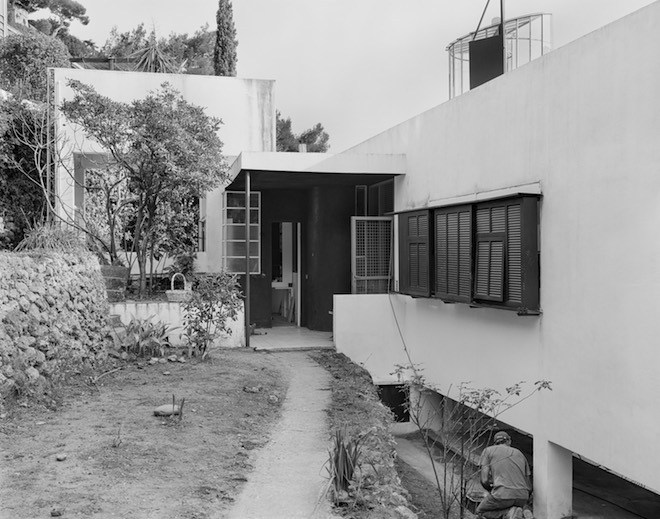Until the 3rd of June, the De La Warr Pavilion in Bexhill-on-Sea, East Sussex, will be transformed by immersive designs created by Copenhagen-based artists Tamar Guimarães and Kasper Akhøj, in collaboration with the designer Frederico Fazenda. This will be the very first public exhibition from Guimarães and Akhøj in the UK, who have previously shown work at LACMA and the Venice Biennale.
The exhibition presents moving image and photographic works that have been selected in response to the modernist architecture of the De La Warr Pavilion, and the curious social history of Bexhill-on-Sea. Together and separately, Guimarães and Akhøj explore the residual histories of art, design and architecture, drawing unexpected connections between states of rapture and modernity. The works on display include Studies for A Minor History of Trembling Matter (2017) and Captain Gervasio’s Family (2014), which both respond to research undertaken in the small Brazilian town of Palmelo, where many the inhabitants are Spiritist mediums. These films appear alongside Guimarães’ Canoas (2010), set in the home that architect Oscar Neimeyer built for himself outside Rio de Janeiro, and Akhøj’s Welcome (to the Teknival), 2009-17, a response to the restoration of Eileen Gray’s modernist villa e.1027. We spoke to Guimarães and Akhøj about the exhibition and its complex and varied works.
Where did the name I blew on Mr. Greenhill’s joints with a very ‘hot’ breath come from?
The phrase appears on the memoirs of Arthur Spray, who lived in Bexhill-on-Sea throughout the 1930s and had a cobbler shop on Station Road, a few streets away from the Pavilion. There, on the upper floor, Spray practised healing, through hypnosis, touch, and blowing on body parts with ‘hot’ and ‘cold’ breath. He understood the universe as composed of thought vibrations, and God, within it, as a wireless broadcasting station. The title invokes a healing impulse that runs, as a theme, throughout the exhibition, like the curtain that unfolds through the space.

Tamar Guimarães, Canoas (film still), 2010 © Tamar Guimarães, Courtesy of the artist and Fortes D’Aloia & Gabriel, São Paulo
How do the works respond to the space they are occupying?
We discussed the space with Rosie Cooper, the Pavilion’s curator, and we all agreed that the window to the sea should stay as open as possible to allow people inside to look out and people outside to look in. But that is counter-intuitive when you are installing works that need darkness and silence, so we devised a large curtain that unfolds throughout the space, appearing and disappearing, so to say. The curtains were designed in collaboration with Frederico Fazenda and we had in mind the sea, the shore, the propagation of sound, the curves found in the work of Oscar Niemeyer and his collaborator Roberto Burle Marx.
There is an interesting connection with the original plans for the pavilion, which included a sculpture by Frank Dobson, who chose to depict Persephone, goddess of vegetation and Queen of the underworld. She was to stand on the Pavilion’s lawn, looking out to sea as if guarding her realm. The curtains function as dividers in the exhibition space but we also want to imagine that it might also stand between the earth and the spirit world, the domain of Persephone.
Take for example, Welcome (to the Teknival). This is a series of photographs of Villa E.1027, and you find many parallels with the pavilion. Known as Maison en Bord de Mer, Villa E.1027 is a modernist icon designed and built between 1926 and 1929 by Eileen Gray, in the Côte d’Azur. Taken from 2008 to 2017, the photographs that make up Welcome (to the Teknival) follow the process of renovation of Villa E.1027, now recognised as patrimony by the French state.

amar Guimarães, Canoas (film still), 2010 © Tamar Guimarães, Courtesy of the artist and Fortes D’Aloia & Gabriel, São Paulo
How do the selected works reflect the last ten years of your careers?
The exhibition is not exactly a summary of our last ten years of work – we both have worked on significant projects that are not on display at the De La Warr Pavilion. But the works were selected in relation to the pavilion, which was designed by Erich Mendelsohn and Serge Chermayeff, and would be known as the People’s Palace – a centre for health and leisure, of health through leisure, that brought the language of modern architecture to the British seaside.
To what extent is Spiritism a theme throughout the exhibition?
Spiritism is not the main theme throughout the exhibition. The exhibition themes are time, illness and recovery, yet two of the works engage with a Spiritist community in Palmelo, a very small town in the Brazilian planes. The town emerged in the 1930s around a Spiritist study group and a sanatorium. Half of the city’s inhabitants are psychic mediums who hold day jobs as teachers and civil servants, and partake in daily rituals of psychic healing. For this community, spirits intervene, teach and transform the material world.

Tamar Guimarães, Canoas (film still), 2010 © Tamar Guimarães, Courtesy of the artist and Fortes D’Aloia & Gabriel, São Paulo
Why did you decide to focus on this particular moment in modernism in your film Canoas?
Casa das Canoas was designed by Oscar Niemeyer and was his home from 1951 to 1957, when he moved to the central plains of Brazil to work on the construction of the new capital, Brasília – a monumental project commissioned by president Juscelino Kubitschek as part of his ‘fifty years of prosperity in five’. During the 1950s, Canoas was the location of many gatherings of political and cultural figures, and its sensuous modernism contributed to the image of Brazil as an emerging modern paradise.
When the film was shot in 2010, there was a similar optimism reigning in Brazil. Yet the film overlaps the times: you have a sense of the past lingering into the present, showing that prosperity is a state of mind, and always only part of the story. And thus, Brazil’s progressive modernism and its often-celebrated ‘racial democracy’ return, as ghosts, promising a future that was not to be.

Kasper Akhoj, Welcome (To The Teknival), 2008-17 © Kasper Akhøj, Courtesy of the artist and Ellen De Bruijne Projects, Amsterdam
What do you think viewers will take away from the exhibition?
That is hard to tell. They might leave thinking of the contrast between the clean lines of modern architecture and the subtle substances that emanate from them; or perhaps of the fragility of plans that appear solid but which must be built on conditions that are permanently revised; they might think of electricity, of thought conduits, of hearing voices, of fits of slumber and of communication that begins with words, but eventually give way to tremors, cries, hums and beats.
Tamar Guimarães and Kasper Akhøj at the De La Warr Pavilion, open until 3rd June 2018.


 PREVIOUS
PREVIOUS

 Twitter
Twitter
 Tumblr
Tumblr
 YouTube
YouTube
 Facebook
Facebook
 Instagram
Instagram
